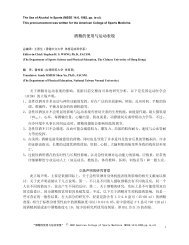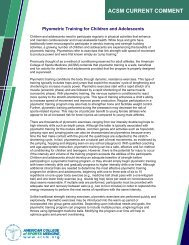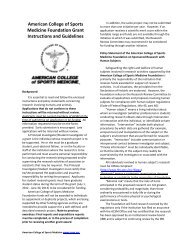Exercising Your Way to Lower Blood Pressure - American College of ...
Exercising Your Way to Lower Blood Pressure - American College of ...
Exercising Your Way to Lower Blood Pressure - American College of ...
You also want an ePaper? Increase the reach of your titles
YUMPU automatically turns print PDFs into web optimized ePapers that Google loves.
heart attack and stroke is lower, even ifyour blood pressure is not reduced <strong>to</strong>normal levels.• Being active is also important for peoplewith pre-hypertension (sys<strong>to</strong>lic pressures<strong>of</strong> 120 <strong>to</strong> 139 and dias<strong>to</strong>lic pressures <strong>of</strong>80 <strong>to</strong> 89) and for people with normalblood pressure who have a family his<strong>to</strong>ry<strong>of</strong> high blood pressure.HOW SHOULD YOU EXERCISE?There are no specific exercises designed<strong>to</strong> lower blood pressure. In fact, manyactivities <strong>of</strong> daily life will be beneficial –like walking, taking the stairs andmoderate <strong>to</strong> vigorous yardwork orhousework.Other beneficial exercises include:• Jogging• Swimming• Cycling• Aerobics• WalkingMild exercises, such as walking, mayreduce blood pressure just as much asstrenuous activities, such as jogging.Physical activity should elevate your heartrate and breathing somewhat, but youshould still be able <strong>to</strong> easily carry on aconversation while doing these activities.Please consult your physician prior <strong>to</strong>engaging in a vigorous exercise program,such as jogging or running.While many blood pressure medicationsmay have negative side effects, the sideeffects <strong>of</strong> exercise are generally positive— helping control weight while improvingglucose levels, cholesterol levels andheart function. Injuries may occur whenyou exercise, but these are minimal if youdon’t overdo it when you start and if youprogress slowly.WAYS TO IMPROVE YOUR HEALTHMost <strong>of</strong> us find it difficult <strong>to</strong> add exercise <strong>to</strong>our already busy day — even if it willimprove our health. However, the physicalactivity required <strong>to</strong> lower blood pressurecan be added without making majorlifestyle changes.Simple changes you can make include:• Park your car further away so you canwalk some <strong>to</strong> and from work.• Take the stairs, not the eleva<strong>to</strong>r.• Take a 10-15 minute walk during yourlunch break.• Choose a restaurant with low-fat, lowcholesteroloptions and walk <strong>to</strong> it forlunch.• Take your children or grandchildren <strong>to</strong>the park.• Take a 30-minute window-shopping walkaround the mall when weather is bad.• Wake up 30 minutes earlier in themorning, and start your day withexercise. Most people find they lookforward <strong>to</strong> their exercise time.• Vary the activities <strong>to</strong> make exerciseinteresting.Any amount <strong>of</strong> physical activity, even lowintensityexercise such as walking, canlower your blood pressure, and the healthbenefits <strong>of</strong> exercise for yourcardiovascular system are substantial anddefinitely worth the effort.STAYING ACTIVE PAYS OFF!Those who are physically active tend <strong>to</strong> live longer,healthier lives. Research shows that moderatephysical activity – such as 30 minutes a day <strong>of</strong> briskwalking – significantly contributes <strong>to</strong> longevity. Even aperson with risk fac<strong>to</strong>rs like high blood pressure,diabetes or even a smoking habit can gain realbenefits from incorporating regular physical activityin<strong>to</strong> their daily life.As many dieters have found, exercise can help youstay on a diet and lose weight. What’s more – regularexercise can help lower blood pressure, control bloodsugar, improve cholesterol levels and build stronger,denser bones.THE FIRST STEPBefore you begin an exercise program, take a fitnesstest, or substantially increase your level <strong>of</strong> activity,make sure <strong>to</strong> answer the following questions. Thisphysical activity readiness questionnaire (PAR-Q) willhelp determine if you’re ready <strong>to</strong> begin an exerciseroutine or program.• Has your doc<strong>to</strong>r ever said that you have a heartcondition or that you should participate in physicalactivity only as recommended by a doc<strong>to</strong>r?• Do you feel pain in your chest during physicalactivity?• In the past month, have you had chest pain whenyou were not doing physical activity?• Do you lose your balance from dizziness? Do youever lose consciousness?• Do you have a bone or joint problem that could bemade worse by a change in your physical activity?• Is your doc<strong>to</strong>r currently prescribing drugs for yourblood pressure or a heart condition?• Do you know <strong>of</strong> any reason you should notparticipate in physical activity?If you answered yes <strong>to</strong> one or more questions, if youare over 40 years <strong>of</strong> age and have recently beeninactive, or if you are concerned about your health,consult a physician before taking a fitness test orsubstantially increasing your physical activity. If youanswered no <strong>to</strong> each question, then it’s likely that youcan safely begin exercising.PRIOR TO EXERCISEPrior <strong>to</strong> beginning any exercise program, including theactivities depicted in this brochure, individuals shouldseek medical evaluation and clearance <strong>to</strong> engage inactivity. Not all exercise programs are suitable foreveryone, and some programs may result in injury.Activities should be carried out at a pace that iscomfortable for the user. Users should discontinueparticipation in any exercise activity that causes painor discomfort. In such event, medical consultationshould be immediately obtained.ACSM grants permission <strong>to</strong> reproduce this brochure if it is reproduced in its entirety without alteration. The text may be reproduced in another publication if it is used in its entiretywithout alteration and the following statement is added: Reprinted with permission <strong>of</strong> the <strong>American</strong> <strong>College</strong> <strong>of</strong> Sports Medicine. Copyright © 2011 <strong>American</strong> <strong>College</strong> <strong>of</strong> SportsMedicine. This brochure was created and updated by James M. Hagberg, Ph.D., FACSM, and is a product <strong>of</strong> ACSM’s Consumer Information Committee. Visit ACSM online atwww.acsm.org.
















